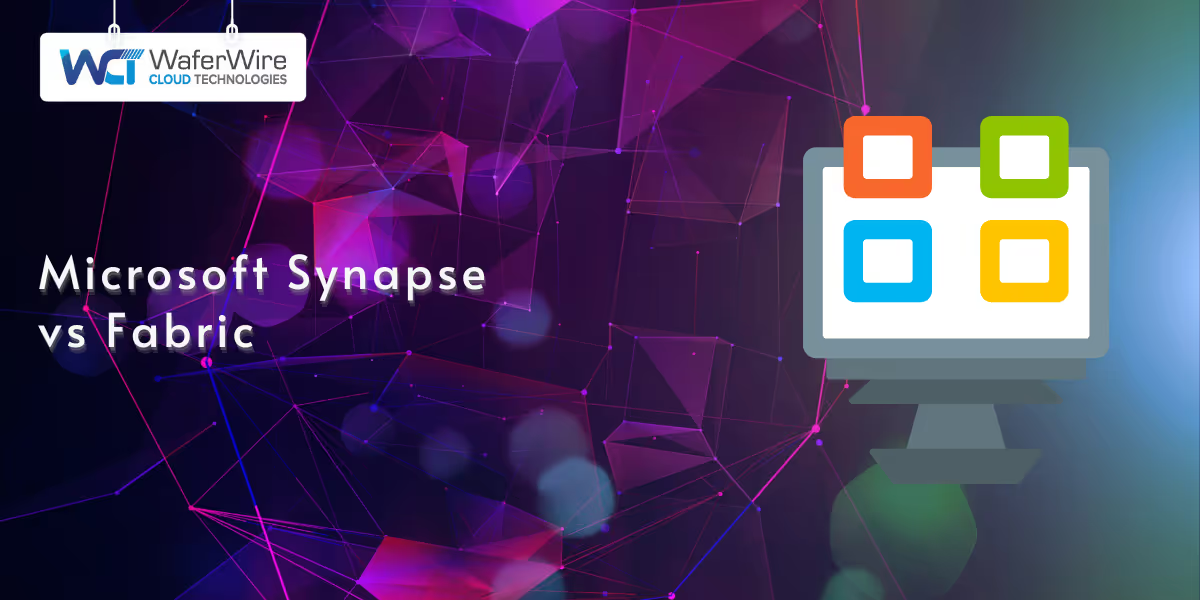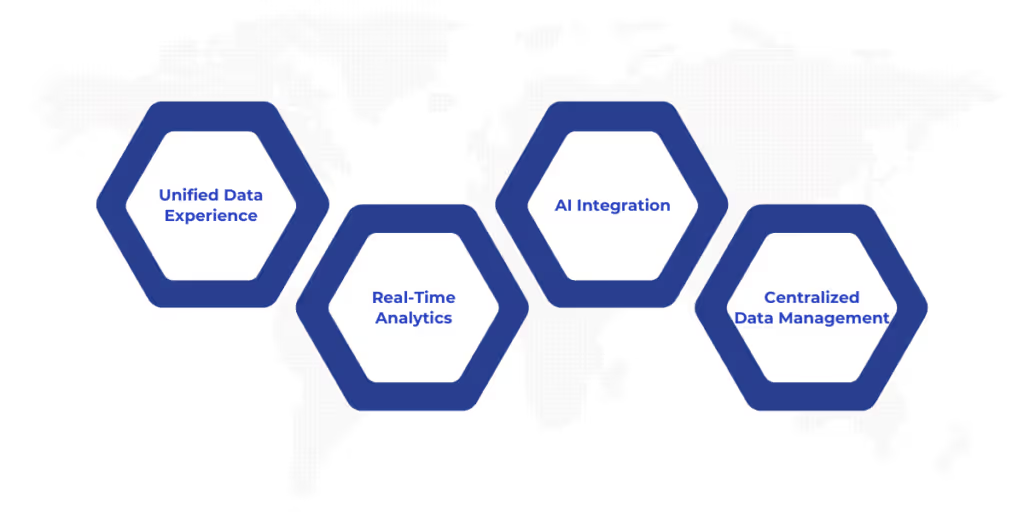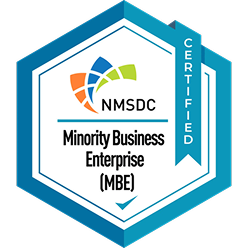

Choosing the right data platform for your business can be a complex decision, especially when two robust solutions like Microsoft Fabric and Azure Synapse are in play. Both platforms are designed to optimize data management and analytics, but they serve different purposes and offer unique advantages depending on your business needs.
In this blog, we will explore the key differences between Microsoft Fabric and Azure Synapse, comparing their features, performance, scalability, and use cases. This comparison will provide the insights you need to determine which platform is the best fit for your organization’s data strategy.
Microsoft Fabric is a unified analytics platform designed to streamline data workflows across various functions, including data engineering, data science, data warehousing, and business intelligence. It integrates several Azure services, such as Azure Synapse Analytics, Azure Data Factory, Azure Machine Learning, and Power BI, into a cohesive environment.
This integration allows organizations to manage their data operations within a single platform, enhancing collaboration and efficiency. Here are the top features of Microsoft Fabric:
Key Features

Azure Synapse Analytics is an integrated analytics service that combines big data and data warehousing. It enables organizations to analyze large volumes of data from various sources, providing insights that drive business decisions.
Synapse offers both on-demand and provisioned query processing, allowing for flexible data analysis approaches. Here are the top features of Azure Synapse:
Key Features
Microsoft Fabric and Azure Synapse Analytics are both powerful data platforms from Microsoft, but they serve different purposes and architectures. Understanding their differences is crucial for organizations deciding which solution aligns best with their data strategy.
The architectural approach determines how easily you can integrate, scale, and manage your data workflows. Let’s compare how Fabric and Synapse handle core infrastructure.
FeatureMicrosoft FabricAzure Synapse Analytics
Unified PlatformYes (End-to-end SaaS, including OneLake, Power BI, Data Engineering, and Data Science)No (Primarily a data warehouse and analytics service)
Data Lake IntegrationBuilt-in OneLake (Single, unified storage for all workloads)Requires Azure Data Lake Storage (ADLS Gen2) as a separate componentCompute & Storage SeparationPartially (Compute tied to capacity units)Yes (Serverless & Dedicated SQL Pools allow independent scaling)
Workloads SupportedData Engineering, Data Warehousing, Real-Time Analytics, Business Intelligence, Data ScienceData Warehousing, Big Data Analytics, ETL/ELT Pipelines
Key Insight:
Cost efficiency is critical when choosing a data platform. Here’s how Fabric and Synapse differ in pricing models and long-term financial implications.
Pricing ModelMicrosoft FabricAzure Synapse AnalyticsBilling ApproachCapacity-based (Fabric SKUs) – Pay for compute and storage in a single planPay-as-you-go (Compute + Storage billed separately)Compute CostsFixed capacity units (F, P, C SKUs)Serverless (per query) or Dedicated (per vCore/hour)Storage CostsIncluded in the Fabric capacitySeparate billing for ADLS Gen2Ideal ForOrganizations wanting predictable costsBusinesses needing flexible, usage-based scaling
Key Insight:
Seamless integration with existing tools can make or break a platform’s usability. Let’s examine how Fabric and Synapse fit into broader data ecosystems.
IntegrationMicrosoft FabricAzure Synapse AnalyticsPower BINative integration (Direct Lake mode for faster queries)Requires data export to Power BI PremiumAzure ServicesTightly integrated with Azure AI, Purview, and TeamsWorks with Azure ML, Databricks, and Event HubsOpen-Source ToolsLimited (Primarily Microsoft-first)Supports Spark, Python, R, and .NETData SharingCross-tenant sharing via OneLake shortcutsRequires Azure Data Share or Synapse Link
Key Insight:
Performance directly impacts how quickly you can derive insights. Here’s how these platforms handle speed, concurrency, and growth:
Performance FactorMicrosoft FabricAzure Synapse AnalyticsQuery SpeedOptimized for interactive analytics (Delta Parquet format)Columnstore indexing for fast data warehousingConcurrencyLimited by capacity unitsWorkload isolation in dedicated SQL poolsReal-Time AnalyticsBuilt-in streaming (KQL databases)Requires Synapse Real-Time Analytics add-onAuto-ScalingManual capacity adjustmentAuto-pause/resume in serverless mode
Key Insight:
Selecting between Microsoft Fabric and Azure Synapse isn’t just a technical decision—it’s a strategic one that impacts efficiency, cost, and long-term agility. With Microsoft's future emphasis on Fabric, businesses should carefully consider migration plans as the industry shifts. The right choice depends on your organization’s existing infrastructure, data maturity, and future goals. Below, we break down the ideal scenarios for each platform and provide actionable guidance to align your selection with business outcomes.
1. When to Choose Microsoft Fabric
Microsoft Fabric excels for organizations looking for a unified, low-friction analytics experience with minimal overhead. As Microsoft continues to emphasize Fabric as the unified solution for analytics,
Consider it if you need:
Who Benefits Most?
2. When to Choose Azure Synapse
Azure Synapse is tailored for businesses requiring flexibility, scalability, and advanced data engineering. While Synapse remains a good solution, Microsoft Fabric is increasingly the recommended platform for organizations transitioning. Opt for Synapse if you need:
Who Benefits Most?
Choosing the right data platform requires careful consideration of your organization’s unique needs and goals. As Microsoft Fabric increasingly becomes the recommended platform for data workloads, aligning your selection with current infrastructure and long-term objectives is essential.
To ensure your platform choice supports your business needs, ask yourself the following key questions:
By considering these guiding questions, you can ensure that your platform choice aligns with both your immediate needs and long-term strategic goals.
As Microsoft consolidates its data analytics vision around Fabric, continuing with Synapse may limit long-term agility and integration. Fabric’s unified platform, simplified pricing, and native support for real-time insights position it as the strategic upgrade for modern enterprises.
Migrating now allows organizations to stay ahead of Microsoft's roadmap while reducing complexity and improving collaboration. This shift is both a technical and strategic move that supports future-ready data operations. Transition with confidence, knowing Fabric is built to evolve with your business needs.
If your organization is evaluating a move from Azure Synapse to Microsoft Fabric, WaferWire can support you through each step. Our experts help align your data strategy with Microsoft’s latest platform direction while ensuring a clear and effective transition.
Contact us to explore how Fabric can meet your evolving data needs and position your business for long-term success.

